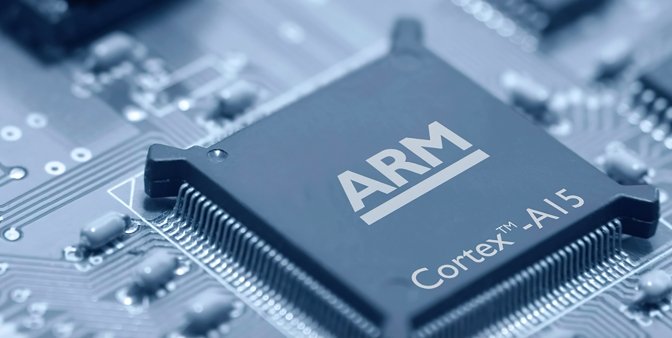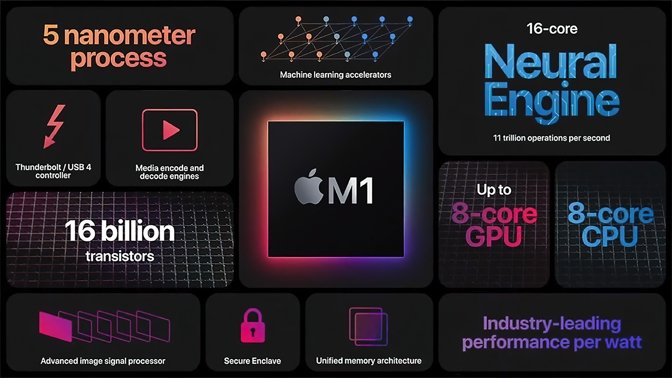Arm's new chip architecture will power future devices, possibly including Apple's
Chip designer Arm Ltd. has announced its new v9 architecture, a design that could eventually appear in the Apple Silicon powering future iPhones, iPads, and Macs.

Arm's new v9 architecture boosts AI, security, and performance
The new Arm v9 focuses on three areas: performance, security, and machine learning (ML) capabilities. Arm says the design will provide more than a 30% CPU performance boost over the next two generations of mobile and infrastructure CPUs.
AI is another critical area Arm targeted with its v9 design. The architecture's new Scalable Vector Extension 2 (SVE2) technology will enhance ML and digital signal processing (DSP) for future devices.
Arm's SCE2 can improve processing for 5G systems, ML, voice AI assistants, and virtual and augmented reality. Apple's Arm-based chips include a Neural Engine that handles ML tasks, and the company is reportedly developing a mixed-reality headset and AR glasses.
Security is the third pillar of Arm's new design. Its Confidential Compute Architecture (CCA) "shields portions of code and data from access or modification while in-use, even from privileged software, by performing computation in a hardware-based secure environment."
The CCA will use a concept called Realms, a "region that is separate from both the secure and non-secure worlds." For example, Arm says a business application could use Realms to protect sensitive data from the rest of the system "while it is in-use, at rest, and in transit."

Apple's M1 chip, powering the latest Macs, uses an Arm design
ARM says that the first devices using the v9 design will arrive by late 2021.
Chips based on the decade-old v8 design offer the best performance-per-watt in computing today. Arm-based chips power nearly every smartphone, along with many tablets and an increasing number of laptops.
Apple Silicon, which uses an Arm v8-based design, will soon power every Apple computing product. All iPhones and iPads use Apple Silicon chips, and the company is in a two-year transition that will end with all Macs running Apple's Arm-based silicon. The Arm-based M1 chip powers the latest MacBook Air, MacBook Pro, and Mac mini.
Nvidia is in the process of buying Arm Ltd. for a record-breaking $40 billion.

Arm's new v9 architecture boosts AI, security, and performance
The new Arm v9 focuses on three areas: performance, security, and machine learning (ML) capabilities. Arm says the design will provide more than a 30% CPU performance boost over the next two generations of mobile and infrastructure CPUs.
AI is another critical area Arm targeted with its v9 design. The architecture's new Scalable Vector Extension 2 (SVE2) technology will enhance ML and digital signal processing (DSP) for future devices.
Arm's SCE2 can improve processing for 5G systems, ML, voice AI assistants, and virtual and augmented reality. Apple's Arm-based chips include a Neural Engine that handles ML tasks, and the company is reportedly developing a mixed-reality headset and AR glasses.
Security is the third pillar of Arm's new design. Its Confidential Compute Architecture (CCA) "shields portions of code and data from access or modification while in-use, even from privileged software, by performing computation in a hardware-based secure environment."
The CCA will use a concept called Realms, a "region that is separate from both the secure and non-secure worlds." For example, Arm says a business application could use Realms to protect sensitive data from the rest of the system "while it is in-use, at rest, and in transit."

Apple's M1 chip, powering the latest Macs, uses an Arm design
ARM says that the first devices using the v9 design will arrive by late 2021.
Chips based on the decade-old v8 design offer the best performance-per-watt in computing today. Arm-based chips power nearly every smartphone, along with many tablets and an increasing number of laptops.
Apple Silicon, which uses an Arm v8-based design, will soon power every Apple computing product. All iPhones and iPads use Apple Silicon chips, and the company is in a two-year transition that will end with all Macs running Apple's Arm-based silicon. The Arm-based M1 chip powers the latest MacBook Air, MacBook Pro, and Mac mini.
Nvidia is in the process of buying Arm Ltd. for a record-breaking $40 billion.

Comments
They are not. All that is required is that Apple's implementation of ARM's v8 ISA remains backwards compatible with the v8 specs. Other than that, Apple is allowed to extend the ISA as needed and they are not required to push those extensions back to ARM.
While the M1 chip has a single core score that rivals Intel Core i7 and i9, the best Cortex Core for PCs and mobile barely surpasses the Intel Pentium. (Qualcomm is hyping up the multicore score, but even there it takes 8 performance cores to merely rival the Geekbench 5 score for the quad core Intel i5). I thought that Apple having their own big core design that ARM Holdings can't come close to was why Nvidia's purchase of ARM Holdings is like "meh" for Apple as their custom CPU and GPU designs are much better - by several times - than Cortex, Mali (the ARM Holdings GPU) and even Nvidia (either their old GPU architecture or their new Ampere one) anyway.
1. The v9 contains things that ARM developed independently that are inferior to Apple's tech.
2. Apple WILL NOT be required to push their ARM designs back. First off, as a co-founder with a permanent architectural license, Apple is for all intents and purposes an independent entity here. Second, even if they weren't, the other ARM licensees like MediaTek, Huawei, Qualcomm and Samsung don't either. This is a real issue because for awhile both Samsung and Qualcomm were able to develop custom CPU cores that were significantly better tham ARM's generic CPU cores. (Samsung fell behind and gave up; Qualcomm's are only slightly better.) And Qualcomm's Adreno GPU design is MUCH BETTER than ARM Holdings' Mali. (The bad ARM GPUs are a major reason why Google uses Intel for Chromebooks. Samsung ditched Mali for an AMD GPU design. Nvidia's mobile GPU design - hardware and software - is much better also.) So if generic licensees like Qualcomm, Samsung and Nvidia aren't required to give up their IP to ARM Holdings there is no way that Apple - whose license is on far better terms - won't.
Basically Nvidia buying ARM has nothing to do with Apple. Nvidia doesn't even want in on the CPU game anyway. They tried that already: they made CPUs for the original batch of Android devices. When companies abandoned them for the Qualcomm/Samsung/MediaTek trio they tried to manufacture and sell their own devices - the Nvidia Shield tablet and the Nvidia Shield set top box - but that failed also. Even the Nintendo Switch uses Nvidia CPU designs that are like 4 years old because Nvidia exited that market and never updated them. The Nintendo Switch Pro will have a slightly updated Tegra CPU, but it still won't use the latest ARM cores or the latest process. Nvidia buying ARM is all about cloud, edge and IoT stuff plus ML/AI stuff, and those are areas that an end user consumer hardware company like Apple only dabbles in.
Apple Silicon uses the same core instruction set (ISA) to ARM, and therefore the same core architecture, more or less, but it ends there. The rest is all Apple. They do this because of their standing with ARM, their license with ARM, and the fact that they're not reselling ARM SoCs to third parties. They have no need to be compliant for the purposes of off the shelf *anything*.
I can't image Apple and ARM not having continual conversations. This new version is not going to be a surprise to Apple engineers and their suppliers.
This is my bone of contention with Cinebench as it ignores a TeraOp of SIMD compute from the AMX units. The M1 should be smashing all but ThreadRipper/Epyc on Cinebench but as it’s Embree renderer is controlled by Intel, that optimisation probably won’t happen.
Long term I suspect what you will see is that Apple will focus a lot of effort on things outside of the ARM cores. This will specifically be focused on high performance AI hardware. In other words the ARM cores, at least for mainstream machines, will become a smaller portion of the entire SoC space allocation.
Apple also has the ability to smoothly pivot to another architecture, such as Risk V, if it desires.
Huawei has been forced to do exactly that, and as a result, perhaps it could be argued that it controls as much, or more, of the 'whole stack' as Apple.
It's 5G modem and WiFi chipsets are designed in house, for example. Apple's aren't.
It can also 'optimise' the stack beyond the CE boundaries of Apple, as it also produces Cloud hardware and services along with AI hardware and services. It also develops it own battery and charging technologies. Not to mention participating in and designing the core communications technologies that are the backbone of today's modern day devices. Apple devices included of course.
In software, GMS is being replaced by HMS etc.
Qualcomm and especially Samsung are also well placed to do the same if necessary but for different reasons, they have no need to.
It's worth noting that Huawei has also been reportedly greenlighted to use ARMv9 and just like all vendors, has the option of using RISC-V too.
Samsung has attempted to, but has never been able to replicate Apple's success and continue to trail in SOC performance, and density, and Qualcomm develops a range of SOC's for its many customers.
As I have stated before; every year, Apple ships about 70% of its units based on its single, current (A14), A series processor, and this year, it appears that Apple will approach 250m iPhone units, which is in the neighborhood of 175 million A14's, not including iPad's. Not in anyone's universe will Qualcomm come close to those numbers for the Snapdragon 888, nor Samsung for the Exynos 2100, nor Huawei for the Kirin 9000.
What's interesting is how much of an advantage Apple continues to carry over its competitors, and the M series is yet another instance.
The amount of processors Apple ships is totally irrevelant. What does that have to do with the advantages of owning the whole stack? And you are making some utterly wild projections anyway. Why not try to run with something that is more realistic, like what they shipped last year? Either way, quantity would still mean nothing but if that is what you want, Mediatek reportedly shipped over 350 million processors last year.
As for the advantage Apple continues to have over competitors, are you claiming that not being able to ship a latest generation 5G modem on SoC is an advantage?
And as for 'the Android fork' (eh?) not being very developed, it already contained more APIs than Google GMS Android, and two days ago, Beta 3 was released, adding 1,000 more APIs. Considering no one outside China has even seen the system, you are jumping to A LOT of uninformed conclusions. Especially as the system already has a release date for handsets: 24 April.
I think we should just wait and see on that one.